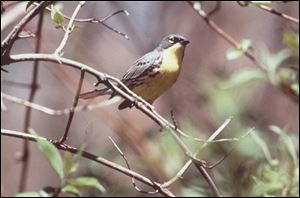
Warbler’s population stabilizes, officials say
Michigan reports 1,805 pairs found
9/20/2011
The Kirtland’s warbler’s picky nesting preferences help explain why they neared extinction.
TRAVERSE CITY, Mich. — The melodic chirp of the Kirtland’s warbler should continue to ring out in the jack pines of northern Michigan — as long as humans provide a helping hand, officials said Monday.
Nearly a quarter century after the songbird’s population fell to a dangerously low 167 pairs, the latest census turned up 1,805 in Michigan and about two dozen in neighboring Wisconsin and Ontario, the Michigan Department of Natural Resources said.
The Michigan total was second only to 1,813 two years ago. More significant, it has not increased or decreased more than 5 percent since 2007, a sign of stability lacking for many years, said Chris Hoving, the DNR’s endangered species coordinator.
“They’ve come into equilibrium with the amount of habitat that’s out there right now,” he said. “I don’t expect it to go up or down much.”
Kirtland’s warblers have bluish-gray backs, yellow breasts, and picky nesting preferences that help explain why they nearly went extinct.
They build nests on the ground beneath jack pine trees that are 5 to 20 feet tall and 4 to 20 years old. Michigan’s northern Lower Peninsula has such trees in abundance.
After the warbler was added to the federal endangered species list in the mid-1970s, agencies began trying to restore its habitat in the northern Lower Peninsula, the only place the birds were known to breed.
Scientists hope the warbler can be taken from the endangered list at some point but are concerned about how the birds may be affected by climate change in the Bahamas, where they spend winters.